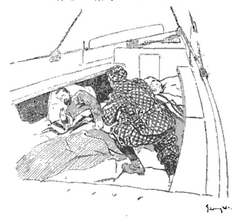Marion Manville Pope facts for kids
Quick facts for kids
Marion Manville Pope
|
|
|---|---|

"A woman of the century"
|
|
| Born | Marion Manville July 13, 1859 La Crosse, Wisconsin, U.S. |
| Died | December 22, 1930 Paris, France |
| Resting place | The M.M. Manville lot in Oak Grove Cemetery, La Crosse, La Crosse county, Wisconsin, USA. |
| Occupation | author |
| Language | English |
| Nationality | American |
| Genre | poetry, juvenile literature |
| Notable works | Up the matterhorn in a boat |
| Spouse |
Charles A. Pope
(m. 1891) |
| Relatives | Helen Adelia Manville Marvin Madison Monroe “M.M.” Manville |
Marion Manville Pope (born July 13, 1859 – died December 22, 1930) was an American writer. She wrote many poems and stories, especially for children. After she got married, she traveled to interesting places like Cuba and Mexico.
Contents
Early Life and Learning
Marion Manville was born in La Crosse, Wisconsin, on July 13, 1859. Her parents were Marvin Madison Monroe Manville and Helen Adelia Manville. Marion was a very active and smart child. Even when she was very young, she wrote many poems. People were often surprised by how good her writing was for her age.
Marion was a well-educated woman with many different skills. She studied at the Lyceum School in New York City.
Writing Career and Travels
Some of Marion's early poems were put into her first book, Over the Divide. This book was published in Philadelphia in 1888. It was very popular and had several printings. Many critics liked her work. Some of her poems were even read aloud by actors.
Marion's poems were widely shared, but she felt her best work was her stories. She loved children very much, which led her to write for them. She wrote both stories and poems for popular children's magazines. These included St. Nicholas Magazine, Wide Awake, Our Little Ones, The Nursery, and Babyhood. Her writing showed not only a gift for poetry but also careful thought. Her poems were clear and well-crafted.
On September 22, 1891, Marion married Charles Alvan Pope. He was also an author and lived in Valparaíso, Chile. After their marriage, she made Valparaíso her home. She also traveled to Cuba and Mexico.
Besides writing, Marion was also a dramatic reader, which means she performed readings of stories and poems. She was also a talented artist. She worked with crayons, oil paints, and pen and ink. She was also good at sculpting, and some of her sculptures were truly artistic. Marion was a popular person in society. Her writings even inspired a famous sculpture called The End of the Trail by James Earle Fraser (1915).
Up the Matterhorn in a Boat
One of Marion Manville Pope's most famous books is Up the Matterhorn in a Boat. It was published in 1897. The Harford Post reviewed the book in Book News: An Illustrated Magazine of Literature and Books.
The review said that Mrs. Pope had found a way to make flying machines work. She created a boat called "The Cloud Queen." In this boat, she takes two typical Americans up the Matterhorn mountain. The story is a funny and wild adventure. It is full of humor, but the author wrote it so realistically that readers almost believe it's true.
The two Americans and their dog have many surprising adventures. They face dangers like avalanches, cliffs, and storms. They even rescue a quiet Englishman from the snow. He adds to the humor of the Americans. The pictures in the book matched the funny spirit of the story.
The Delineator magazine also reviewed the book in 1898. They called Up the Matterhorn in a Boat a strange and funny story. They thought it might prepare people for future flights in the sky. The book has funny parts, sad events, and struggles with cold and hunger. It also uses a lot of slangy talk, which might have come from their strange experiences. The magazine recommended the book for its humor and for making readers laugh. They said it was funny all the way through. They also thought Marion Manville Pope must be a very jolly person to have invented such a tale.
Books by Marion Manville Pope
- Over the divide and other verses, 1888
- Up the matterhorn in a boat, 1897
- A judicial error
- Between two gods : [an allegory], 1917



